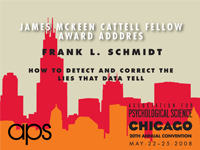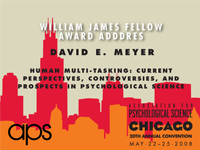Sharpening the Learning Curve
If learning is a lifelong journey, it’s probably safe to say that most of us would be grateful for a few shortcuts along the way. The “Learning, Competitiveness, and Real-World Achievement” program at the APS 20th Annual Convention focused on new strategies to help people learn more quickly, from children developing basic math skills to work groups adopting new procedures in large organizations.
From the Classroom…
At the most basic level, success in learning depends largely on motivation and the ability to bounce back from mistakes. Jennifer Mangels, Baruch College, CUNY, and several colleagues address this in their research on how an individual’s neural response to feedback about mistakes interacts with their mindset about mistakes. Mangels and her team found that students motivated to improve their own ability and increase their own knowledge of a particular subject are more likely to learn from their incorrect answers on tests and subsequently answer correctly in follow-up tests. These students showed neural evidence, measured in event related potentials, of less emotional processing of negative feedback and deeper processing of information that they could use to correct their answer on a later test. On the other hand, students with a more fixed view of their ability in a given subject (“You either have it or you don’t”) may instead feel threatened and “withdraw” when faced with errors (“I’m horrible at this”) and, therefore, are less likely to use mistakes as learning opportunities. These feelings can be triggered by the environment as well — for example, female students taking math tests are less likely to improve after feedback if gender differences are pointed out and a sense of competition is introduced.
APS Fellow Art Markman, University of Texas, Austin, more closely links the study of motivation to learning in his research. He first determined that matching the structure of the test (gaining points for correct answers or losing points for incorrect answers) with a similar reward structure (offering a reward for a good performance on a test or threatening to take something away for a bad performance) produces better results than when the two are mismatched. This sort of match allows people more flexibility, and they can more quickly discover complex rules that will help them complete a task.
Flexibility is often a benefit when an element of competition is introduced; individuals being rewarded for exceeding their own best performance are more successful when they are allowed flexibility in the task then when they are taught a specific rule. On the other hand, people being rewarded for exceeding another’s performance have better results when they follow a strict rule than when they are left to their own devices. Markman’s research also examined how pressure affects these results, and he found that those who follow a strict rule when completing a task are more likely to “choke” under pressure than those with a more flexible approach.
APS Fellow and Charter Member Robert Siegler, Carnegie Mellon University, also found that properly matching teaching materials with content aids learning. Siegler examined the use of games to help teach basic understanding of numerical magnitudes to children from low-income families and found that number-based board games (akin to Chutes & Ladders) were more effective than color-based board games (akin to Candy Land). Siegler recently delved more deeply into this and tested how the shape of the “game field” on the playboard affects learning. The results indicate that board games with a linear game field (where the playing spaces are in a straight line) are more useful than games with a circular game field, thus suggesting that seeing the numbers in a straight line better aided the children in developing a sense of magnitude (“10 is further from 1 than 5 is”).
…to the Boardroom
Learning on our own in a classroom is one thing, but learning in an office environment as part of a group or team is a different beast altogether. A group’s success at learning depends as much on the interaction between group members as it does on their individual abilities. In his review of the current literature on team learning, APS Fellow and Charter Member Daniel Ilgen, Michigan State University, found three overarching approaches: a cognitive focus on how the team learns, a developmental/adaptive view of how learning occurs over time and how it utilizes the member’s skills and abilities, and an organizational perspective that looks at the organization as a whole from the outside and how the climate and structure can affect a team’s ability to learn. Ilgen believes that further research of team learning should better integrate individual and team processes to more completely understand the system as a whole. In addition, he suggests that researchers should use more models and simulations and that they should form their own teams with members of multiple disciplines to understand group learning “from the inside.”
In all this group learning (and in research), mistakes will eventually be made. But as Michael Frese, University of Giessen and London Business School, made clear in his presentation on error management, “there is life after error.” Error management is the practice of accepting and dealing with mistakes as they arise. This strategy is meant to complement, not replace, the more common error-prevention approach (learning to avoid mistakes entirely). Although learning to perform and function “the right way” to achieve an error-free end result is ideal, treating errors as learning opportunities encourages exploration and may lead to better strategies in the future. This mindset also helps relieve the stressful feelings that often accompany a mistake, as it leads to open communication and quicker discovery of and recovery from errors. It even has some effect on the bottom line: a study by Frese and colleagues showed that companies which had a strong error management culture had a 25% chance to be among the most highly profitable companies in comparison to a 6% chance to be in this highly profitable group among the companies with a low error management culture.
Learning from one’s mistakes may be a valuable tool, but it only works if an organization embraces it. A team leader that punishes members who admit to mistakes or those who voice different ideas on how to do things denies the team opportunities to learn. In her research, Amy Edmondson, Harvard Business School, found that the patient care units with the highest levels of teamwork in two different hospitals were the ones reporting the most mistakes. The common thread among these high-ranking teams was the sense of psychological safety — the feeling that one can admit to mistakes and speak up with new ideas without the fear of punishment. “Fear is local,” Edmondson explained, and this fear within some teams creates an environment where communication is guarded and, thus, learning opportunities are scarce.
Edmondson also surveyed neonatal intensive care unit (NICU) teams to determine other factors that improved a team’s quality of work and its ability to implement new techniques. She found that the NICU teams were more likely to adopt procedures supported by high levels of evidence (numerous studies, statistics, etc.) and that the teams who assessed, evaluated, or practiced new procedures in simulations or “dry runs” were more successful at implementing the technique. Psychological safety factors into the effectiveness of these simulations as well, as open communication is needed to best modify the technique to the team’s needs.
Several of the researchers presenting at the “Learning, Competitiveness, and Real-World Achievement” theme program commented on the remarkable cohesiveness of the program and how well the different presentations supported each other. With such a solid foundation, research on how we learn appears to be on a very promising path. And any bumps and potholes along the way can be thought of as “learning experiences.”




APS regularly opens certain online articles for discussion on our website. Effective February 2021, you must be a logged-in APS member to post comments. By posting a comment, you agree to our Community Guidelines and the display of your profile information, including your name and affiliation. Any opinions, findings, conclusions, or recommendations present in article comments are those of the writers and do not necessarily reflect the views of APS or the article’s author. For more information, please see our Community Guidelines.
Please login with your APS account to comment.